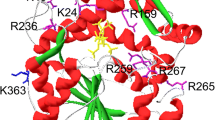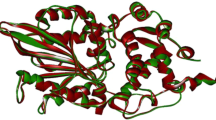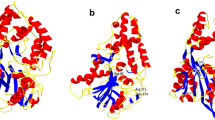Abstract
Due to our previous research, mainly the thermostable mutants Q307D, Y311K, and I427L, we conjectured that Escherichia coli AppA phytase’s C-terminal plays an important role in its thermostability, and AppA begins to collapse from the C-terminal when at a higher temperature. So here we constructed C-lose mutant to prove it. The residual activities of the wild-type AppA phytase and C-lose were 31.42 and 70.49 %, respectively, after being heated at 80 °C for 10 min. The C-terminal deletion mutant C-lose showed 39.07 % thermostability enhancement than the wild-type both without the pH and temperature optimum changed. It proved the C-lose plays a key role in E. coli AppA phytase’s thermostability.





Similar content being viewed by others
References
Eijsink VG, Bjørk A, Gåseidnes S, Sirevåg R, Synstad B, van den Burg B, Vriend G (2004) Rational engineering of enzyme stability. J Biotechnol 113:105–120
Garrett JB, Kretz KA, Donoghue EO, Kerovuo J, Kim W, Barton NR, Hazlewood GP, Short JM, Robertson DE, Gray KA (2004) Enhancing the thermal tolerance and gastric performance of a microbial phytase for use as a phosphate-mobilizing monogastric feed supplement. Appl Environ Microbiol 70(5):3041–3046
Haefner S, Knietsch A, Scholten E, Braun J, Lohscheidt M, Zelder O (2005) Biotechnological production and applications of phytases. Appl Microbiol Biotechnol 68(5):588–597
Han YM, Lei XG (1999) Role of glycosylation in the functional expression of an Aspergillus niger phytase (phyA) in Pichia pastoris. Arch Biochem Biophys 364:83–90
Han YM, Wilson DB, Lei XG (1999) Expression of an Aspergillus niger phytase gene (phyA) in Saccharomyces cerevisiae. Appl Environ Microbiol 65:1915–1918
Kim MS, Lei XG (2008) Enhancing thermostability of Escherichia coli phytase App A2 by error-prone PCR. Appl Microbiol Biotechnol 79(1):69–75
Kumar S, Tsai CJ, Nussinov R (2000) Factors enhancing protein thermostability. Protein Eng 13:179–191
Lei XG, Stahl CH (2001) Biotechnological development of effective phytases for mineral nutrition and environmental protection. Appl Microbiol Biotechnol 57(4):474–481
Lim D, Golovan S, Forsberg CW, Jia Z (2000) Crystal structures of Escherichia coli phytase and its complex with phytate. Nat Struct Biol 7(2):108–113
Luo H, Huang H, Yang P, Wang Y, Yuan T, Wu N, Yao B, Fan Y (2007) A novel phytase appA from Citrobacter amalonaticus CGMCC 1696: gene cloning and overexpression in Pichia pastoris. Curr Microbiol 55(3):185–192
Pack SP, Yoo YJ (2003) Protein thermostability: structure-based difference of residual properties between thermophilic and mesophilic proteins. J Mol Catal B Enzym 26:257–264
Querol E, Perez-Pons JA, Mozo-Villarias A (1996) Analysis of protein conformational characteristics related to thermostability. Protein Eng 9:265–271
Ragone R (2001) Hydrogen-bonding classes in proteins and their contribution to the unfolding reaction. Protein Sci 10:2075–2082
Rodriguez E, Wood ZA, Karplus PA, Lei XG (2000) Site-directed mutagenesis improves catalytic efficiency and thermostability of Escherichia coli pH 2.5 acid phosphatase/phytase expressed in Pichia pastoris. Arch Biochem Biophys 382(1):105–112
Selle PH, Aaron J, Cowieson AJ, Ravindran V (2009) Consequences of calcium interactions with phytate and phytase for poultry and pigs. Livestock Sci 124(1–3):126–141
Szilágyi A, Závodszky P (2000) Structural differences between mesophilic, moderately thermophilic and extremely thermophilic protein subunits: results of a comprehensive survey. Structure 15:493–504
Vieille C, Zeikus JG (1996) Thermozymes: identifying molecular determinants of protein structural and functional stability. Trends Biotechnol 14:183–190
Vieille C, Zeikus GJ (2001) Hyperthermophilic enzymes: sources, uses, and molecular mechanisms for thermostability. Microbiol Mol Biol Rev 65:1–43
Wyss M, Brugger R, Kronenberger A, Remy R, Fimbel R, Oesterhelt G, Lehmann M, van Loon AP (1999) Biochemical characterization of fungal phytases (myo-inositol hexakisphosphate phosphohydrolases): catalytic properties. Appl Environ Microbiol 65(2):367–373
Yip KS, Stillman TJ, Britton KL, Artymiuk PJ, Baker PJ, Sedelnikova SE, Engel PC, Pasquo A, Chiaraluce R, Consalvi V (1995) The structure of Pyrococcus furiosus glutamate dehydrogenase reveals a key role for ion-pair networks in maintaining enzyme stability at extreme temperatures. Structure 3:1147–1158
Zhu W, Qiao D, Huang M, Yang G, Xu H, Cao Y (2010) Modifying thermostability of appA from Escherichia coli. Curr Microbiol 61(4):267–273
Acknowledgments
This study was supported by National Science Funds Committee (31272659, 30971817), and National twelfth five-year science and technology support program (2011BAD14B05), Sichuan Science and Technology Bureau (2010GZ0290, 2012GZ0008, 2010GZ0065, 2011GZ0027).
Author information
Authors and Affiliations
Corresponding author
Rights and permissions
About this article
Cite this article
Fei, B., Cao, Y., Xu, H. et al. AppA C-terminal Plays an Important Role in its Thermostability in Escherichia coli . Curr Microbiol 66, 374–378 (2013). https://doi.org/10.1007/s00284-012-0283-4
Received:
Accepted:
Published:
Issue Date:
DOI: https://doi.org/10.1007/s00284-012-0283-4




